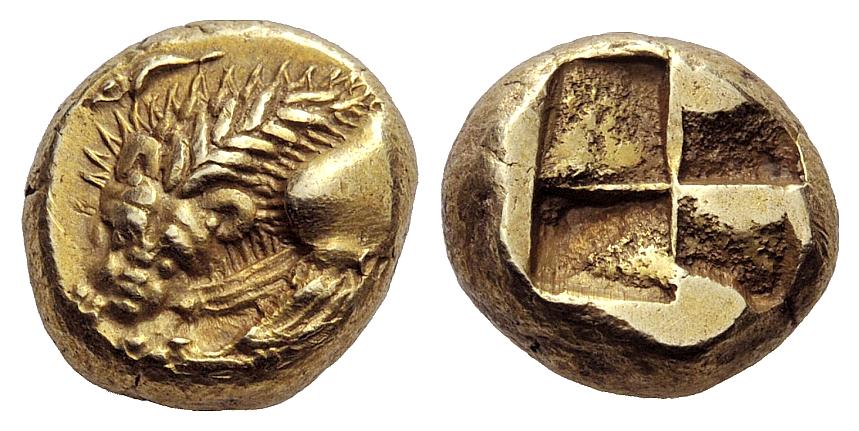AC 221 - Phocaea, electrum, hektai (521-478 BCE)
From SILVER
521 BCE - 478 BCE Electrum 61,545 kg
Description
| ObverseInscription or printing placed on the obverse.: | Forepart of lion to left, eating prey held in its forepaws, above left, seal to left. |
| ReverseInscription or printing placed on the reverse.: | Quadripartite incuse square. |
Mint and issuing power
| MintIdentifies the place of manufacture or issue of a numismatic object.: | Phocaea | Ancient regionAncient region.: | Ionia | Modern countryModern country: Turkey | AuthorityIdentifies the issuing power. The authority can be "pretended" when the name or the portrait of X is on the coin but he/she was not the issuing power. It can also be "uncertain" when there is no mention of X on the coin but he/she was the issuing power according to the historical sources: |
Chronology
| FromIdentifies the initial date in a range assigned in a numismatic context. | 521 BCE | toIdentifies the final date in a range assigned in a numismatic context.. | 478 BCE | PeriodTime period of the numismatic object.: Archaic until 480 BC |
Physical description
| MetalThe physical material (usually metal) from which an object is made.: | Electrum http://nomisma.org/id/el | Median weightMedian of the weights of numismatic objects (in grams). in grams | 2.50 | DenominationTerm indicating the value of a numismatic object. Examples: tetradrachm, chalkous, denarius.: | hekte |
StandardStandard.: |
Image

AC 221 Phokaia Hekte 521-478.jpg [1]
References
| Die study referencePublication of the study: | Bodenstedt 19811Bodenstedt 1981, émissions 29-50. | ||
| Coin series referenceReference to coin series study: | Sear II2Sear II, n° 3498-3499, RQEMAC3RQEMAC, n° 221 | ||
| Coin series web referenceCoin series web references: | |||
Obverse dies distribution
| FrequencyFrequency of specimen in distribution. ᵖ | Number of obversesNumber of obverse dies. ᵖ (o) | % (o) | Number of coinsNumber of coins. (n) | % (n) | Die nameName(s) of the die(s). |
| 1 | 39 | 54.17 | 39 | 28.47 | 3ob, 30d, 30e, 32a, 32f, 33a, 33c, 33d, 33e, 35a, 36a, 36b, 36c, 36d, 36e, 36f, 36g, 36h, 37a, 37d, 37e, 39a, 39b, 39c, 42a, 43a, 43c, 43e, 43f, 43g, 44b, 44c, 45b, 46b, 46d, 47a, 49a, 49b, 50c |
| 2 | 16 | 22.22 | 32 | 23.36 | 29b, 30f, 30g, 31a, 31b, 32c, 32d, 32e, 35b, 37c, 40a, 43b, 43d, 46c, 50a, 50b |
| 3 | 10 | 13.89 | 30 | 21.9 | 30a, 30c, 32b, 33b, 34a, 35c, 37b, 41b, 46a, 50d |
| 4 | 4 | 5.56 | 16 | 11.68 | 29a, 38a, 41a, 45a |
| 5 | 1 | 1.39 | 5 | 3.65 | 44a |
| 7 | 1 | 1.39 | 7 | 5.11 | 37f |
| 8 | 1 | 1.39 | 8 | 5.84 | 48a |
| Total | 72 of 72 | 100.01 | 137 of 137 | 100.01 |
Reverse dies distribution
no distribution is available
Quantification
| Number of obversesNumber of obverse dies. ᵖ (o) | 72 | Number of singletons (o1)The number of singleton coins. ᵖ | 39 |
| Number of reverse diesNumber of reverse dies. (r) | NC"NC" is not a number. | Number of coinsNumber of coins. (n) | 137 |
| Coins per obverse dieNumber of coins per obverse die. (n/o) | 1.9 | Coins per reverse dieNumber of coins per reverse die. (n/r) | |
| Reverse per obverse ratioRatio of obverse dies divided by reverse dies. (r/o) | Percentage of singletons (o1)number of coins (n) divided by the number of singletons (o1) ᵖ | 54.17 % | |
| Original number of dies (O) (Carter 1983 formula)The estimation of the number of coins according to Carter 1983 ᵖ | 123.09 | Coins struck if 20,000 as average productivity per dieCoins made if the average productivity for obverses (according to Carter) is 20,000. ᵖ | 2,461,800 |
| Original number of dies (O) (Esty 2011 formula)The estimation of the number of coins according to the singleton formula in Esty 2011 ᵖ (O) | 151.75 | Survival rate if 20,000 as average productivity per dieSurvival rate if average productivity is 20,000. ᵖ | 0.00006 |
| Coverage (o = % of O) (Esty 1984 formula)Esty 1984 - coverage (% of O) ᵖ (o = % of O) | 71.53% | Die productivity if survival rate 1/2,000Average productivity if survival rate is 1/2,000. ᵖ | 2,226.01 |
| Weight of silver (in kg) if 20,000 coins per die (O = Carter formula)Carter 1983 * Median weight * 20000 (*10 if gold or electrum) ᵖ | 61,545 kg <br /> 61,545 kg | Die productivity if survival rate 1/5,000Average productivity if survival rate is 1/5,000. ᵖ | 5,565.03 |
Remarks
References
- ^ Bodenstedt, Friedrich (1981), Die Elektronmünzen von Phokaia und Mytilene, Tübingen.
- ^ Sear, David R. (1979), Greek coins and their values. Vol. II, Asia and North Africa, London, xlviii, p. 317-762
- ^ Callataÿ, François de (2003), Recueil quantitatif des émissions monétaires archaïques et classiques, Numismatique Romaine, Wetteren, VII + 267 p.